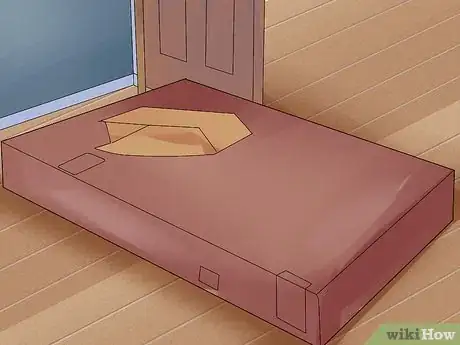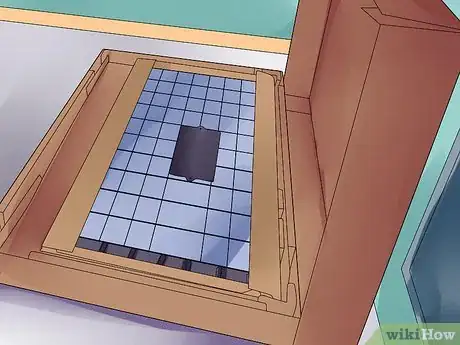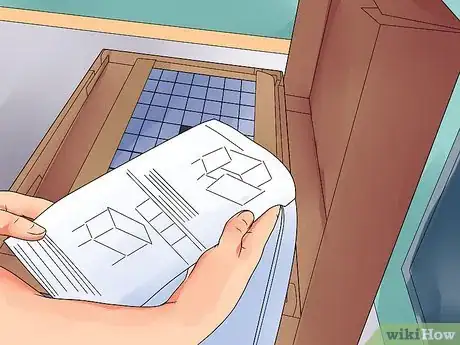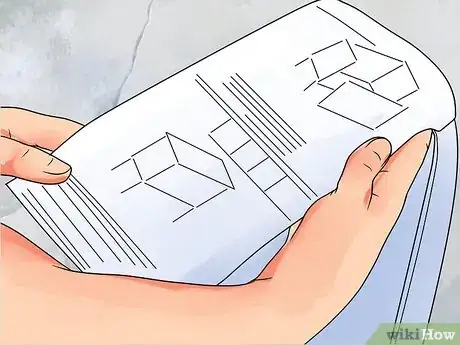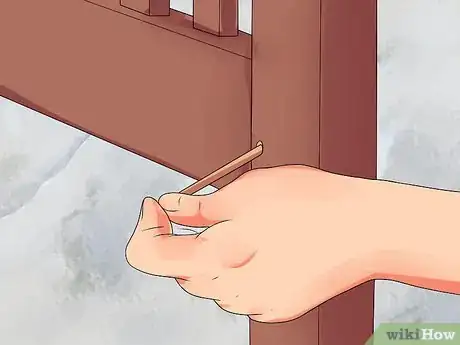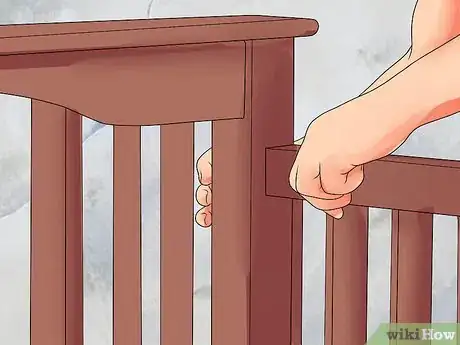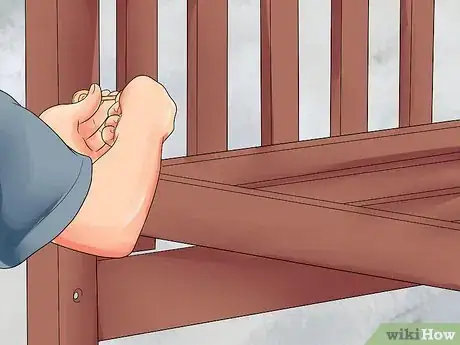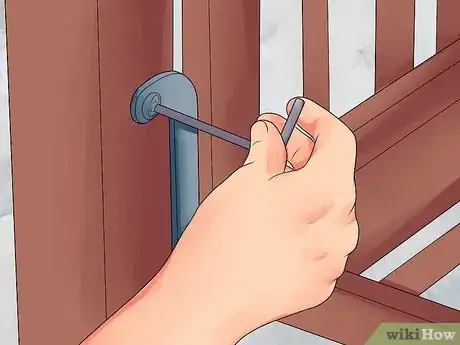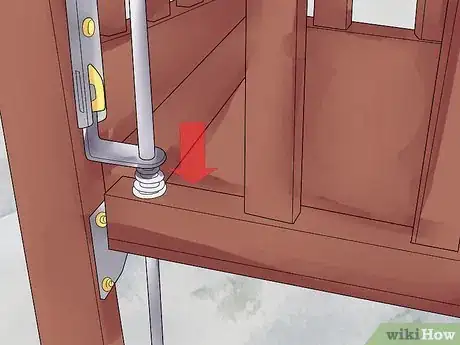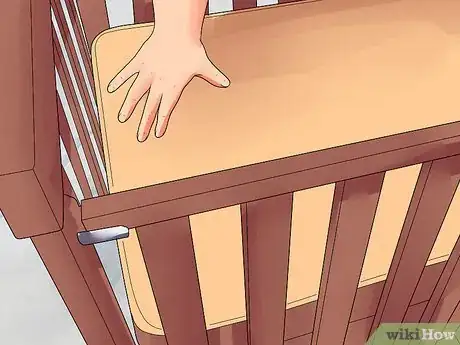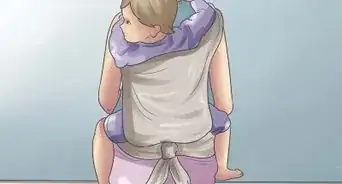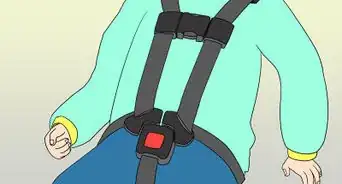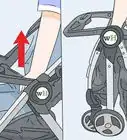wikiHow is a “wiki,” similar to Wikipedia, which means that many of our articles are co-written by multiple authors. To create this article, 17 people, some anonymous, worked to edit and improve it over time.
This article has been viewed 221,375 times.
Learn more...
Although there are many different types and brands of cribs, most basic cribs have the same functional pieces. Some specifics may differ between brands and styles but the general guidelines for assembling a crib are mostly the same. It takes just a little effort and a few steps to safely build your baby’s new crib.
Things You Should Know
- Unpack the crib pieces and make sure you have everything listed on the assembly instructions.
- Lay the headboard flat on the ground and attach the latch brackets onto the inside of the headboard (if they aren't already attached).
- Attach the stationary rail to the headboard and footboard. Then, attach the mattress support to the base of the crib.
- Attach the drop rail(s) to the front of the crib and slide the mattress into place.
Steps
Prepping the Pieces
-
1Bring everything to the baby room. It is best to assemble the crib in the baby room so that you do not have to move the crib around once you have finished assembling it. They can be large and awkward to move around, and it may be difficult getting it through the door.[1]
-
2Unpack the crib. If it is new in a box it will come in several pieces. Everything you need to assemble the crib should be included in the box with the crib and you probably will not need any extra tools unless your particular instructions call for them.
- If your crib does require tools then you might need a Phillips screwdriver, hammer and/or ratchet set. Read your instructions to find out which tools, if any, you need.
Advertisement -
3Check that you have all the pieces as listed in the instructions. If not, you will need to call the store and exchange the crib for a new one.[2]
- If for some reason you do not have the instructions then you can still check to make sure you have all the pieces. Most cribs will include a headboard, footboard, rails (the long sides of the crib; one rail is usually a drop rail, meaning that it can lower so that you can access your baby easily), some kind of mattress support (can be simply a board or can be a board with springs) and a mattress. It may also have two long thin side boards as support between the headboard and footboard, especially if both rails can move up and down (drop rails).
-
4Check the condition of the pieces of your crib. Make sure that none of the pieces are damaged, for example showing splintered wood or peeling paint. This is especially true for secondhand cribs although you should also check the condition of new cribs to make sure they are safe for your baby.[3]
- If you see any damage such as splintering, mold, peeling paint, sharp corners or dampness then you will want to test your pieces carefully and perhaps obtain a new crib. Damaged pieces have the possibility of breaking, potentially harming your baby. You should also make sure that the spacing between the slats is no wider than 2 3/8 inches (6 cm).[4]
-
5Read the instructions carefully. Every crib has its own particular instructions that you should follow carefully. It is important to be attentive to these instructions because a mistake in assembling a crib could actually endanger the baby's life. Be thorough, and don't rush.
- If you do not have instructions for your crib, perhaps if you lost them or are using a secondhand crib, often you will be able to find the manufacturer’s instructions online. Go the the website of the manufacturer and search for your crib model to try to obtain these.
- If you still cannot find the instructions then it should not be hard to figure out how to assemble the crib. Since most cribs have the same basic pieces it shouldn't be difficult to figure out how to assemble the crib.
Assembling the Pieces
-
1Lay the headboard flat on the ground. Lay the headboard flat on the ground with the side facing inwards to the crib showing up. You can recognize this side by the holes for the brackets or dowels that will usually exist on the inward side.[5]
- Some beds show little difference between the headboard and footboard. Simply choose one of the pieces and lay that one on the ground facing up.
-
2Attach the latch brackets onto the inside of the headboard. These brackets will eventually attach the headboard and footboard to the mattress support so they must be facing the inside of the crib.
- Some headboards might already have the latch brackets attached; if so move on to the next step.
- Cribs that have long thin side boards (usually those with drop rails on each side) will attach differently. For these, insert the hardware of the side board into the headboard and footboard. If there is a location to screw these pieces together then you should do so.
- For newborns you will want the base of the crib at the highest level so you would attach the brackets or side rails at this level. Older babies will need a lower crib base.
-
3Attach the stationary rail to the headboard and footboard. Most stationary rails will have dowels on the ends. Slide the dowels into the latch brackets on the headboard and footboard on one side of the crib and screw them to the crib.
- This attachment might require you to screw the rail in place. Using your Phillips screwdriver, screw the pieces together. They should be tight enough that the rail does not shake.
- Sometimes your stationary rail will not have dowels but rather attach only by screws. In this case use your Phillips screwdriver to attach these screws to the rail. Again, this should be tight enough that the rail does not shake.
- If your crib has side boards and two drop rails then you will not yet attach the rails. Skip to the next step.
-
4Attach the mattress support to the base of the crib. The mattress support will be a board, a panel (looks like a ladder) or springs in a frame, depending on your particular crib. This is what the mattress will be resting on so it is very important that this be secure. Slide it into the appropriate height and attach to the headboard and footboard using either screws, nuts and bolts or another type of fastener, depending on your particular crib.[6]
- If your crib is new you may need to attach some parts such as brackets to the mattress support before attaching it to the headboard and footboard.
- For newborns attach the mattress support at the highest possible height. Older babies will need slightly more space and thus the mattress support should be placed lower, depending on the age of your baby.
- There will usually be a manufacturer sticker showing which side faces down on the mattress support.
- If you have a crib with two drop rails then you will attach the mattress support before attaching either of the sides. This way you can reach down into the crib more easily while attaching the support.
-
5Attach the drop rail(s) to the front of the crib. Stand the drop rail onto the latch brackets on the headboard and footboard. Each side of the drop rail will have a metal rod, which is used for sliding the rail up and down. Insert the metal rods into the holes in the headboard and footboard and attach using screws (or another fastener depending on your model crib).
- You should first attach the bottom of the rods on each side before attaching the tops to secure the rail and keep it steady while you are working.
-
6Slide the loose springs over a dowel and insert it just above the bottom hole in the drop side rail. On the edge of your mattress support may be two loose springs. Pull them over a dowel and insert the dowel just above the bottom hole of the drop side rail. This will prevent your drop rail from falling all the way down to the floor if it is not secured properly.
-
7Check the soundness of the crib. Shake the crib. It should not wobble when you try to shake it. The drop-side(s) should also be firmly attached, not loose, and be able to slide up and down. This is to ensure the safety of your baby.[7]
-
8Slide the mattress into the crib. There will not be any hardware to go with the mattress; you can simply lower it into the base of the crib and let it rest there.
- There should be no more than two fingers' width between crib side and mattress. This ensures your baby’s safety when moving or rolling around.[8]
-
9Attach the wheels if you wish. Some cribs may have wheels on the bottom to make them easier to move around. Slide the wheels into the holes on the bottom of the four posts of the crib to secure them. Be certain they work properly both in movement and while locked.
- There should be locks on at least two of the wheels to prevent the crib from moving around while your baby is inside.
-
10Check your crib weekly for loose bolts and sharp edges and ensure proper bedding. Keep your baby safe for as long as the crib is in use by checking that the bedding is not too hot, the crib is in good condition and that your baby is not too big. This will help keep your baby safe while using your baby crib.[9]
- Usually you would stop using the crib when the baby is 32-35 inches (81-89 cm) tall or climbing out of the crib.
- If your baby is able to climb out of his/her crib, you can also lower the bottom portion to keep your baby safe.
Community Q&A
-
QuestionWhat screws and/or nails are needed to put the bed together?
 ChristopherTop AnswererOnly use the screws that were included with the crib itself. Look for key words in the booklet next to the screw listings (such as "not included") to know whether you'll need to go out and purchase certain screws. If they are not included, go to your local hardware store and purchase them, but bring the booklet with you to ensure the list of screws has been copied down correctly.
ChristopherTop AnswererOnly use the screws that were included with the crib itself. Look for key words in the booklet next to the screw listings (such as "not included") to know whether you'll need to go out and purchase certain screws. If they are not included, go to your local hardware store and purchase them, but bring the booklet with you to ensure the list of screws has been copied down correctly. -
QuestionWhat size screws are needed when no screws are included?
 Community AnswerI've never heard of a crib that didn't provide screws. But if it didn't, measure the size of the hole and go to your hardware store. You might consider taking pictures of the holes with measuring tape to bring with you. Ask the clerk for assistance and advice, as washers or special screw types might be better for certain projects. Alternatively, if the crib is new and is missing pieces, contact the maker. Often, you can order replacement parts. This may also be an option for a used crib.
Community AnswerI've never heard of a crib that didn't provide screws. But if it didn't, measure the size of the hole and go to your hardware store. You might consider taking pictures of the holes with measuring tape to bring with you. Ask the clerk for assistance and advice, as washers or special screw types might be better for certain projects. Alternatively, if the crib is new and is missing pieces, contact the maker. Often, you can order replacement parts. This may also be an option for a used crib.
Warnings
- Check the condition of your crib weekly for any damage such as loose bolts that could potentially cause injury to your baby. You should also make sure that your drop rail is locking into place properly.⧼thumbs_response⧽
- Always follow the instructions provided by the manufacturer. This is the surest way to maintain appropriate use and safety.⧼thumbs_response⧽
- Check often on the Consumer Product Safety Commission website to make sure your crib has not been recalled by the manufacturer. Many drop sides have been recalled by manufacturers because of the risk of injury.⧼thumbs_response⧽
References
- ↑ https://www.parents.com/baby/nursery/cribs/how-to-put-together-a-crib/
- ↑ https://www.parents.com/baby/nursery/cribs/how-to-put-together-a-crib/
- ↑ https://onsafety.cpsc.gov/blog/2010/02/12/safe-sleep-part-1-the-crib/
- ↑ http://www.cpsc.gov/en/Business--Manufacturing/Business-Education/Business-Guidance/Full-Size-Baby-Cribs/
- ↑ https://www.parents.com/baby/nursery/cribs/how-to-put-together-a-crib/
- ↑ https://www.parents.com/baby/nursery/cribs/how-to-put-together-a-crib/
- ↑ https://www.whattoexpect.com/pregnancy/ask-heidi/crib-safety.aspx
- ↑ http://www.cpsc.gov/en/Business--Manufacturing/Business-Education/Business-Guidance/Full-Size-Baby-Cribs/
- ↑ https://kidshealth.org/en/parents/products-cribs.html
About This Article
The right way to assemble your crib may vary depending on the brand you have, but the general process is usually the same for most brands. First, place the headboard flat on the ground and attach the latch brackets to the headboard, which will hold the rails in place. Then, slide the stationary rail, which will form the back of the crib, into the holes on the headboard and footboard, and add any screws if they’re included. You’ll also need to slide the mattress support,which is a panel that will hold up the mattress, in at the appropriate height and secure it with screws or bolts. Attach the drop rail to the latch brackets and secure the metal rods on each side, which allow the rail to move up and down. Shake the crib to test if it’s securely put together, then lower the mattress inside. Remember to check the crib regularly for any loose screws or fittings so your baby stays safe. For tips on how to find the manufacturer’s instructions for assembling your crib, keep reading!
